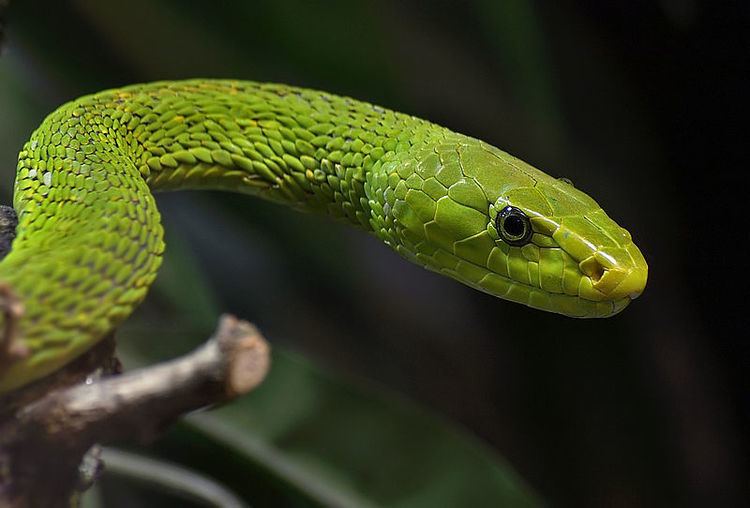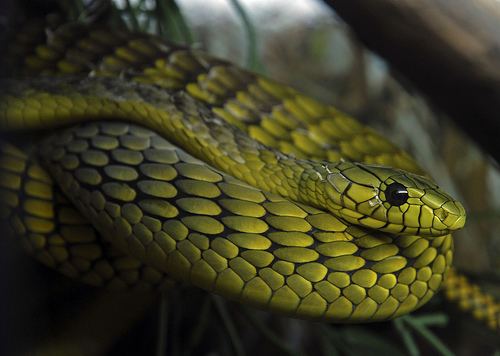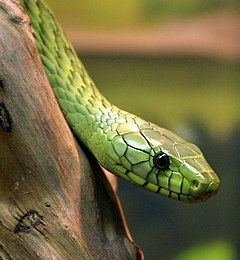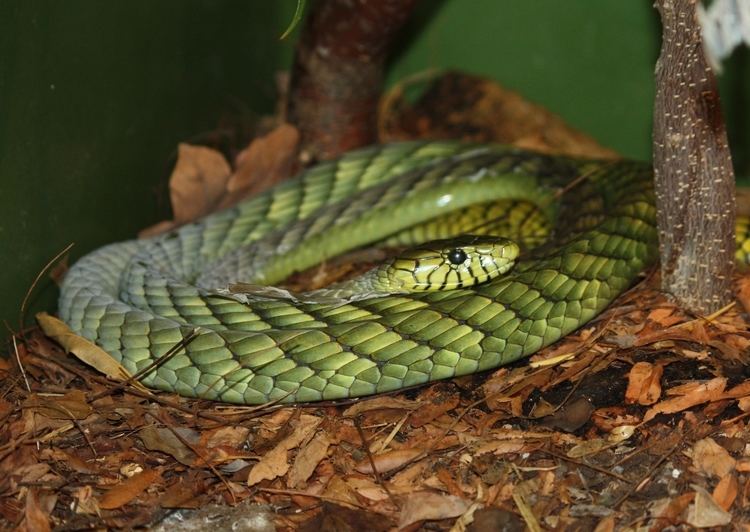Scientific name Dendroaspis viridis Rank Species | Phylum Chordata Suborder Serpentes Subfamily Elapinae Higher classification Mamba | |
 | ||
Similar Mamba, Snake, Eastern green mamba, Reptile, Jameson's mamba | ||
Western green mambas
The western green mamba (Dendroaspis viridis), also known as the West African green mamba or Hallowell's green mamba, is a long, thin, and highly venomous snake of the mamba genus, Dendroaspis. This species was first described in 1844 by the American herpetologist Edward Hallowell. The western green mamba is a fairly large and predominantly arboreal species, capable of navigating through trees swiftly and gracefully. It will also descend to ground level to pursue prey such as rodents and other small mammals.
Contents
- Western green mambas
- Western green mamba
- Taxonomy
- Description
- Scalation
- Distribution and habitat
- Conservation status
- Behaviour and ecology
- Diet and predators
- Venom
- References

The western green mamba is a very alert, nervous, and extremely agile snake that lives mainly in the coastal tropical rainforest, thicket, and woodland regions of western Africa. Like all the other mambas, the western green mamba is a highly venomous elapid species. Its venom is a highly potent mixture of rapid-acting presynaptic and postsynaptic neurotoxins (dendrotoxins), cardiotoxins and fasciculins. Some consider this species to not be a particularly aggressive snake, but others have suggested that they are extremely nervous and are prone to attack aggressively when cornered. Conflict with humans is low compared to some other species found in the region. Bites to people by this species are quite uncommon. Their mortality rate, however, is high; many of the recorded bites have been fatal. Rapid progression of severe, life-threatening symptoms are hallmarks of mamba bites. Bites with envenomation can be rapidly fatal.

Western green mamba
Taxonomy

Dendroaspis viridis was first described by the American herpetologist and physician Edward Hallowell in 1844. In addition to being called the western green mamba, this species is also commonly known as the West African green mamba or Hallowell's green mamba.
The generic name, Dendroaspis, derives from Ancient Greek dendro (δένδρο), meaning "tree", and aspis (ασπίς), which is understood to mean "shield", but also denotes "cobra" or simply "snake", in particular "snake with hood (shield)". Via Latin aspis, it is the source of the English word "asp". In ancient texts, aspis or asp often referred to the Egyptian cobra (Naja haje), in reference to its shield-like hood. Thus, "Dendroaspis" literally means tree asp, reflecting the arboreal nature of most of the species within the genus. The genus was first described by the German ornithologist and herpetologist Hermann Schlegel in 1848. Slowinski et al. (1997) pointed out that the relationships of the African genus Dendroaspis are problematical. However, evidence suggests that Dendroaspis, Ophiophagus, Bungarus, and Hemibungarus form a solid non-coral snake Afro-Asiatic clade. The specific name viridis is of Latin origin and means "green".
Description
The western green mamba is a long and very slender bodied snake with a long tapering tail. The average length of an adult snake of this species is between 1.4 metres (4.6 ft) and 2.1 metres (6.9 ft). Some specimens of this species can grow to maximum lengths of 2.4 metres (7.9 ft). The head is narrow and elongate, with a distinct canthus and slightly distinct from the neck. On rare occasions the neck may be flattened when the snake is aroused, but there is no hood. Eyes are medium in size with round pupils and a yellow brown iris.
Scalation
Dorsal surface body colour is vivid yellowish green to green with anterior margins of the scales yellow. In many specimens the posterior body and tail are yellow. In some specimens, dorsal body scales are distinctly bordered with black forming chevron shaped markings. The black interstitial skin is clearly visible especially highlighting individual head scales and scales on the tail. Head dorsum is similar to dorsal surface anterior body colour or slightly darker green. Laterally, the head scales, particularly the labials, are distinctly black edged and colouration is usually paler than dorsum or slightly yellowish tinted. When viewed from above the black edging of scales and black interstitial skin result in a plaited appearance. Head venter, throat, ventral and subcaudal surface colour is pale yellowish to yellowish green.
The head, body and tail scalation of the western green mamba:
Distribution and habitat
The western green mamba is native to West Africa. Different sources give slightly different ranges but generally agree that it occurs from Gambia and southern Senegal to Benin, including the intervening countries (from west to east) Guinea-Bissau, Guinea, Sierra Leone, Liberia, Cote d'Ivoire (Ivory Coast), Ghana, and Togo. In Togo it has a known northern limit to its distribution in Aledjo, but it might occur in forests of the more northerly Kara region Records from Nigeria might be unreliable, and its presence in the Central African Republic is similarly unclear. Some sources mention it also from the very southern tip of Mali along the border with Côte d'Ivoire, as well as from western Cameroon and Gabon.
Western green mambas live mainly in the coastal tropical rainforest, thicket, and woodland regions of western Africa. The majority of records of the western green mamba are from within the continuous forest, but the Gambia and Guinea-Bissau records are from isolated forests. The species persists in areas where the tree cover has been removed, providing that sufficient hedges and thicket remain. Found in some suitably vegetated suburbs and towns and parklands therein. It is largely confined to areas where rainfall exceeds 1,500 millimetres (150 cm). In Togo, however, its range extends into the drier open forests of the north, the Guinean savannas of the west, and the littoral zone.
Conservation status
This species is classified as Least Concern (LC) on the IUCN Red List of Threatened Species (v3.1, 2011). The conservation status of this species was last assessed in July 2012 and published in 2013, and it was classed as such due to a wide distribution, fairly generalist habits, stable population and the lack of major threats.
Behaviour and ecology
This species is mostly diurnal, but may be active at night as well. It is an arboreal snake, but it does commonly go to the ground. In fact, it is equally at home hunting and feeding on prey on the ground or in trees. When it wants to sleep it seeks out tree branches that offer dense cover. It is a very quick, extremely agile, alert, and nervous snake. When confronted it will quickly attempt to escape (usually up a tree if possible) and avoid any sort of confrontation. If cornered, the western green mamba is highly dangerous and will show a fearsome display of aggression, loudly hissing and striking repeatedly.
Diet and predators
The western green mamba's natural prey consists mainly of birds and small mammals, including rodents such as mice, rats, and squirrels. Other mammals include bats, tree pangolins, and shrews. They also feed on lizards, frogs, and bird eggs. This snake pursues its prey, striking rapidly and often until the prey succumbs to the venom.
The western green mamba, as a large and highly venomous snake, has very few natural predators, but humans and birds of prey are this snake's main threats.
Venom
The western green mamba's venom is similar to those of other members of the mamba genus (Dendroaspis), but differs from others in toxicity and the composition of the toxins. The venom consists mainly of both pre-synaptic and post-synaptic neurotoxins, cardiotoxins, and fasciculins. The toxicity of the venom can vary tremendously depending on various factors including diet, geographical location, age-dependent change, and other factors. The SC and IV LD50 for this species is 0.79 mg/kg and 0.71 mg/kg, respectively (Christensen and Anderson (1967)). One study determined the LD50 of the venom administered to mice via the intraperitoneal (IP) route was 0.33 mg/kg. In another test using mice that were administered the western green mamba's venom via the intraperitoneal (IP) route the LD50 was 0.045 mg/kg. Another experimental IV LD50 toxicity of 0.5 mg/kg has been reported, with an average wet venom yield of 100 mg. Like other mamba species, western green mamba venom is among the most rapid-acting venom of snakes.
Human fatalities as a result of bites from this species are rare due to the fact that this species does not often cross paths with humans, but bites have occurred and the majority of the recorded bites have been fatal. The three species of green mambas, including the western green mamba, have venom toxicities that are similar to and comparable to many species of cobras, but green mamba bites often present with more severe and life-threatening symptoms in a shorter period of time. Mortality rates are also higher among green mamba bite victims than with cobra bite victims. Although bites by Dendroaspis viridis are not well documented and the rate of bites, envenoming and fatality is not well known, it appears that bites attributed to this species produce more severe envenomation than bites caused by Dendroaspis angusticeps (eastern green mamba), but far less severe than bites caused by Dendroaspis polylepis (black mamba). When bitten, symptoms rapidly begin to manifest, usually within the first 15 minutes or less. The extraordinary speed with which the venom spreads through tissue and produces rapid manifestations of life-threatening symptoms is unique to mambas. Common symptoms of a bite from a western green mamba include local pain and swelling, although uncommon, local necrosis can be moderate, ataxia, headache, drowsiness, difficulty breathing, vertigo, hypotension (low blood pressure), diarrhea, dizziness, and paralysis. Left untreated, new and more severe symptoms rapidly progress. All symptoms worsen and the victim eventually dies due to suffocation resulting from paralysis of the respiratory muscles. Bites with envenomation can be rapidly fatal, which can be possibly in 30 minutes.
